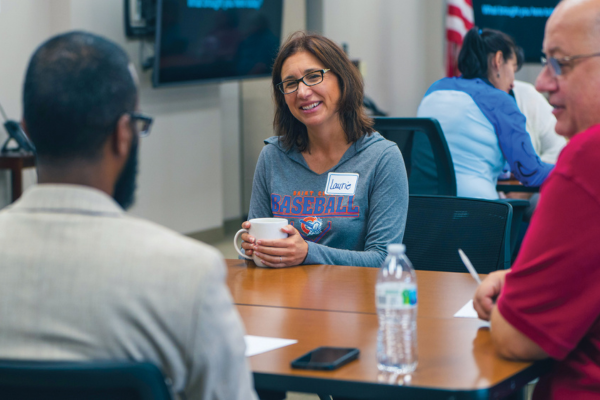'Impatience Born of Experience'
February 01, 2023
Retirement Tribute: Dan Domenech
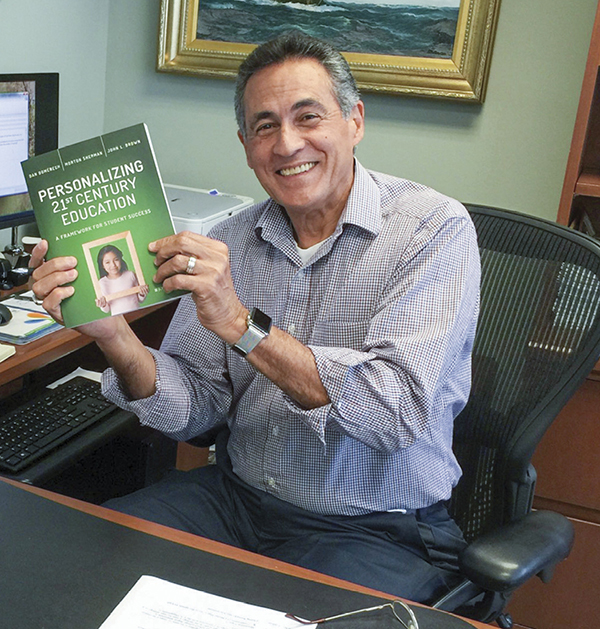
In his first full-time teaching job, 23-year-old Dan Domenech was assigned to a class in Queens, N.Y., with 35 challenging 6th graders. Rather than spending the year struggling with them, he experimented with behavior modification techniques he had studied at Queens College.
Domenech created a token economy, doling out tokens for good behavior that students could turn in for privileges. “One of the big privileges was they would go around the corner with me to have lunch at my house, where my mother would make us sandwiches after we shot some hoops,” he recalls.
One year, he based the curriculum on “Fiddler on the Roof,” intertwining it with reading, writing, math and history, and finally having his students perform excerpts from the show for the student body at the elementary school. The show was a hit, but more importantly, his students’ attendance, behavior and academic performance rose markedly.
“It was a lot of fun for me, and it was a lot of fun for the kids,” he says. “It makes the point that when kids are engaged and doing something they enjoy, they learn in the process.”
A Disruptive Inclination
Domenech, now 77, who will retire this month after almost 15 years as AASA’s executive director, never stopped innovating or, as he puts it, “disrupting.”
One of his recent disruptions may be his most ambitious. He teamed the association with the Successful Practices Network to create a commission of 30 superintendents, CEOs and foundation leaders to develop what has become the Learning 2025 initiative. Its modest goal? “To totally redesign schools, education, from the way it is, which is a throwback to the 18th century, to the way it should be in the 21st century,” he says.
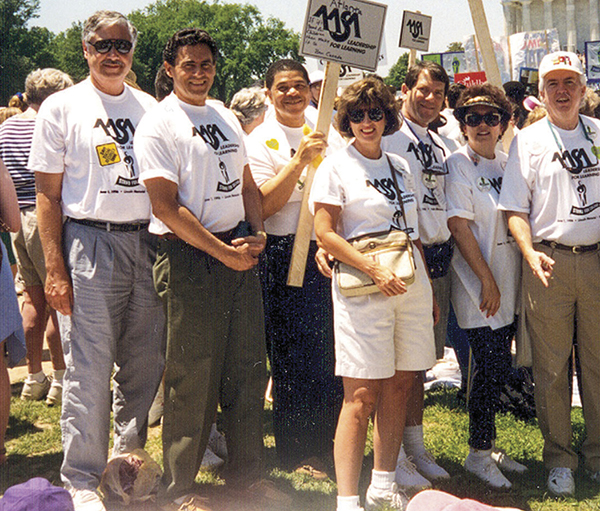
The initiative, which already has drawn more than 130 school districts across the country, grew in part from the chaos COVID-19 has wrought in schools, shattering traditional notions of schooling and prompting urgent discussions about virtual learning, year-round schooling, flexible grade levels, personalized learning and other nontraditional practices.
Domenech says he wants to see 300 districts participating in the initiative in the short term and, ideally, a couple of thousand by 2025.
“I’m trying to kind of imitate the disruptive technology concept, where when you get 20 to 30 percent all of a sudden using a certain technology, it switches over and everybody wants to do it,” he says.
A ‘Colleague-Leader’
It was no surprise to Mort Sherman, AASA’s senior associate executive director, to see Domenech take on such a bold project so late in his career. In an early conversation about the idea, he says Domenech simply declared, “You know, if we don’t do it, who will?”
“He saw the problem,” says Sherman, whom Domenech brought aboard the organization in 2013 to expand professional growth opportunities for current and aspiring leaders. “He quickly said yes to being the co-lead of the commission, and he works tirelessly to share the work across the country.”

David Schuler, superintendent of Township High School District 214 in Arlington Heights, Ill., who will succeed Domenech as executive director later this month, got a similar response from Domenech when he asked for AASA’s support for Redefining Ready!, a college- and life-readiness initiative he developed in his district before sharing with others through an AASA network.
“He didn’t skip a beat at all,” says Schuler, a past president of AASA. “He said, ‘Go for it, David, that’s exactly what we need in public education.’ It would have been just as easy for him to have rolled his eyes and said, ‘There’s a lot of other people who are taking a run at this, Dave, let’s let them do it,’ but that’s just not his style.”
Schuler and others who have worked with Domenech say it’s also not his style to slow-walk a project once it’s been approved. Domenech visited Schuler’s district in suburban Chicago to observe the program before AASA launched Redefining Ready! nationally.
“You’re not going to go into a meeting with Dan and talk, and then come back two weeks later and talk about the same thing again,” Schuler says. “There has to be a plan, and if he and his leadership team give their thumbs up, action will take place.”
Adds Sherman, who spent time as superintendent of five school districts: “He’s always been about the doing, the acting, not just the white paper on the shelf somewhere. It’s an impatience born of experience.”
Despite Domenech’s unwillingness to sit still, Sherman considers him a consummate team player. “When I introduce Dan, I introduce him as a colleague and as a friend, never as a boss,” he says. “As a colleague, he gives us tremendous latitude and respect to do our work. He is very much like a colleague-leader.”
‘Sink or Swim’

Domenech’s early school experiences were of the “sink or swim” variety, he says. He was born in Cuba, where his grandfather owned a sugar cane plantation while his father spent much of his time in New York City overseeing the sugar sales. At 9, he relocated with his family to Manhattan. They flew into Newark, N.J., in January.
“All I remember is the plane door opening and it was like opening the door to a refrigerator,” he says. “I had never experienced cold weather. I didn’t even have a coat, and my father wrapped me in a blanket and carried me down the steps of the plane.”
With both parents working long hours, he was sent to a Catholic boarding school in Tarrytown, N.Y., along the Hudson River. He didn’t speak English and no one in the school spoke Spanish. He had been a 5th grader in Cuba but was placed in a 2nd-grade class, where he languished.
“I pretty much spent my days sitting in the back of the classroom by a window when the Tappan Zee Bridge was being built,” he says. “I would look at the workers on the bridge and assign names to them — that was Manuel and this was Jorge and that was Juan.”
One day he surprised his teacher by solving “advanced” arithmetic problems, and the next day he was moved up to 5th grade, where he was promptly bullied because he spoke Spanish. He hung on at the school for eight miserable months before his parents brought him back to Manhattan.
As his English improved, so did his appreciation of school. At 15, he got a summer job working with children who were newly arrived in the country, preparing them for school in September.
“I would wear my white shirt and tie and stand in front of the group as their teacher,” he says. “That’s what got me into education. I loved it, and I decided that’s what I wanted to do.”
Climbing the Ladder
Despite his fondness for teaching, his career in the classroom was short-lived. “I loved it, but I only got to do that three years because I was promoted,” he says with a laugh.
While teaching the 6th graders in Queens, he was pursuing a doctorate in education research at Hofstra University. This led to a job at the Nassau County Board of Cooperative Educational Services, where he studied innovative instructional practices and introduced them to area schools.
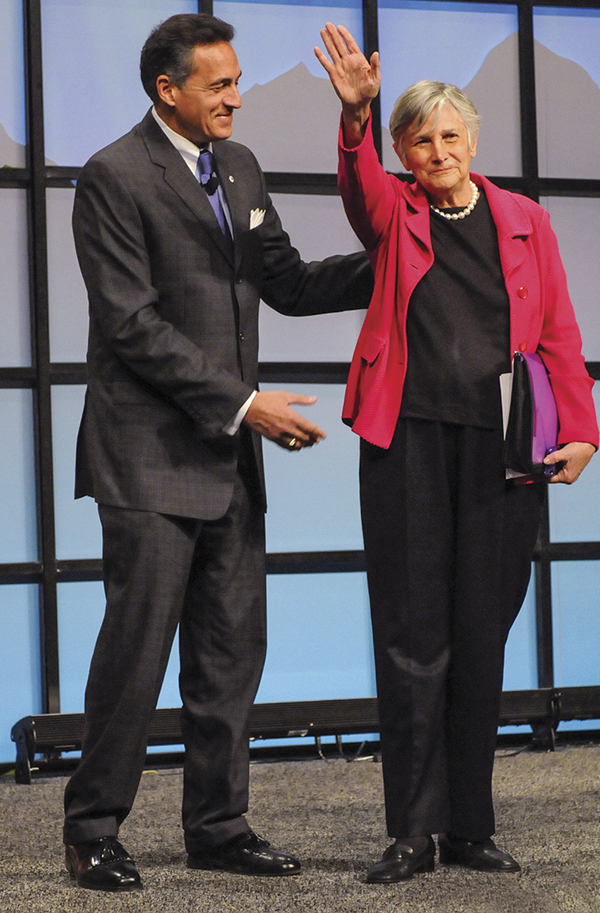
Domenech with education historian Diane Ravitch, a keynote speaker at the AASA National Conference on Education in 2011.
Six years later, with doctorate in hand, Domenech entered school administration, landing an assistant superintendency in the Deer Park district on Long Island. A few months later, the superintendent was fired and Domenech got an interview for the job. He proposed an ambitious plan to close two elementary schools and introduce full-day kindergarten, personalized learning, open-space classrooms and other innovations. He was offered the job on the eve of his 32nd birthday, an especially young age at the time for someone entering the superintendency.
Three years in, he moved on to lead the larger South Huntington School District on Long Island, where he introduced similar innovations, including bilingual instruction and on-site day care services for the children of teachers and district parents. He stayed there for 13 years, then accepted the superintendency at Long Island’s Western Suffolk BOCES, an appointment of the state education commissioner.
Lessons in Politics
Domenech thought that move would include a hefty pay boost, but when the retiring superintendent of the BOCES, who was making $200,000, departed with a $960,000 severance package, then-Gov. Mario Cuomo was incensed. He persuaded the state legislature to cap the salaries of BOCES superintendents at $128,625.

Suddenly Domenech’s pay was not only lower than what he earned in his old job, but less than his assistant superintendents were making at his new one.
During that time, the top job in the New York City School District opened up, and friends encouraged him to apply.
On a Friday night in September 1995, the city’s board of education voted to appoint him chancellor of the largest school district in the country. Domenech’s photo appeared on the front page of The New York Times the following morning. A profile called him “an educator with fire” and described Domenech as “a man suited for the pressures of politics as well as those of boardroom and classroom.” He spent the day doing interviews and accepting congratulations.
But by law, the appointment still had to be ratified at a public meeting that night. Then-Mayor Rudy Giuliani, who had made it clear he wanted more control over the city’s schools, spent that day pressuring board members to change their votes. In a 4-3 revote that night, with Domenech and his family looking on in the first row, the board rescinded his appointment.

“It was shocking,” he admits. “It was crushing. It taught me a huge lesson that I never forgot over the years — about the role of politics in education and how you can’t ignore the politics.”
But even before his encounter with Giuliani, Domenech had demonstrated his political savvy by taking on the long-troubled Roosevelt Junior-Senior High School in Nassau County.
At the state education commissioner’s request, he led an inspection team into the school and produced a scathing report, writing, “If a community could be charged with child neglect, possibly with abuse, Roosevelt would be a strong candidate.”
The New York Times noted that Domenech showed a “deft political stroke” in managing the intervention, which culminated in the state’s first takeover of a school district. It also wrote that he does not “suffer from a lack of confidence or a reluctance to speak his mind. Now and then he has straddled the line that separates frank from brash.”
Reacting to that now, Domenech says, “I would say that’s very appropriate. I’ve never been shy about telling it like it is.”
Tough Decisions
Following his New York experiences, as one of the nation’s most prominent figures in K-12 education, Domenech vied for the superintendency in Los Angeles and was one of three finalists before he took himself out of the running. A year later, he was named superintendent of the Fairfax County School District in Virginia, the 12th largest district in the country.
In his customary style, he hit the ground running. Within his first two years, he worked with the school board to group elementary students by skill level rather than age, offer full-day kindergarten, and open Advanced Placement and International Baccalaureate classes to all students who wanted to take them, a rare practice at the time. AP and IB participation soared.
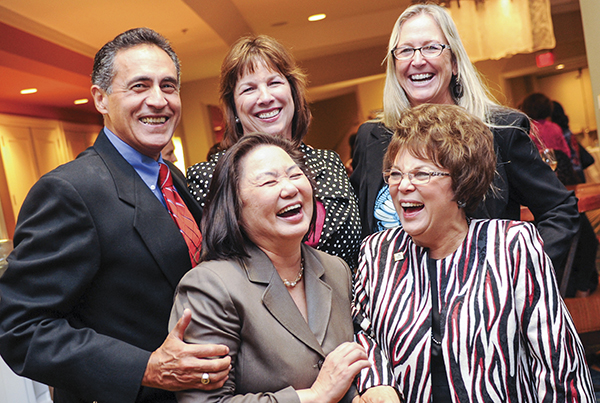
“Districts like Fairfax have shown that many more kids are ready than teachers and counselors think,” observes Jay Mathews, a Washington Post education columnist who covered Fairfax at the time. “So Fairfax, with Dan’s leadership, started to encourage all kids, particularly low-income kids, to do AP or IB.”
After seven years at Fairfax, Domenech accepted a job as a senior vice president at McGraw-Hill Education, where he built relationships with large school districts nationwide.
Four years later, he moved on to AASA, as the eighth executive director in its 158-year history. Immediately, he had some difficult calls to make. It was 2008, and the nation was heading into the Great Recession. The organization wasn’t ready for it, having gone through six deficit budgets in as many years.
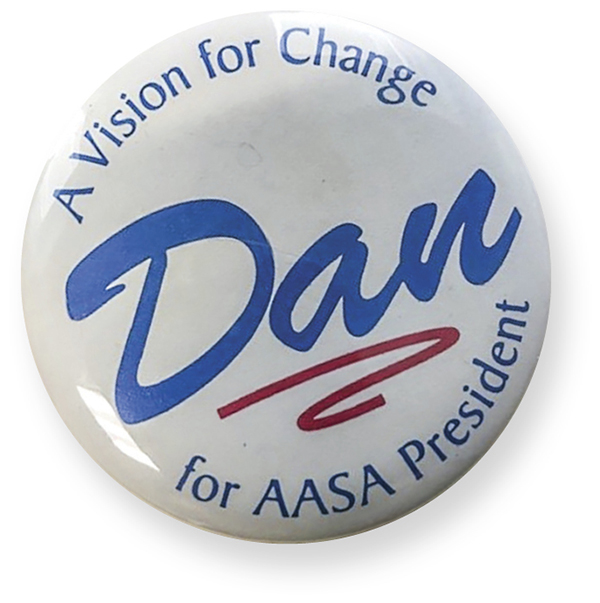
One of his first moves was to make the excruciating decision to lay off 15 of the organization’s 50 employees. He also bought out AASA’s lease on its top-floor offices in Arlington, Va., and purchased a building for the association in Alexandria, Va. The move cut facility expenses almost in half.
“There were hard decisions that had to be made to get things straightened out in the organization,” says Chuck Woodruff, who had worked with Domenech in the Fairfax County schools and joined him as chief operating officer at AASA. “He is willing to and does make the tough decisions.”
In part because of those early decisions, Woodruff says, AASA is now in “the best financial situation it’s ever been in.”
Driven by Mission
Perhaps the most impactful accomplishment in Domenech’s tenure at AASA is formation of the Leadership Network, which has significantly expanded the organization’s mission, membership and bottom line.
“It was a dream that Dan and I shared to create an Urban Superintendents Academy,” says Sherman, who heads the network.
One of the first moves was to approach Howard University and the University of Southern California to help AASA create academies for superintendents of color. “That was clearly an initiative we undertook. There weren’t people banging on our doors,” Sherman says. “But it’s a really important part of who Dan is. It’s not just building programs, but programs that are mission-driven — mission in the sense of serving America.”
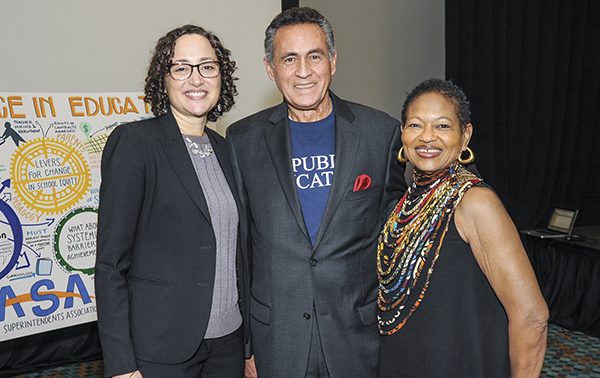
Gail Pletnick, a past AASA president and former superintendent in Arizona who consults with AASA’s Aspiring Superintendent Program and Personalized Learning Cohort, says increasing equity for educators and the children they serve is what drives Domenech’s work.
“He is an inspirational leader who operates from his own values and belief system, and I think that’s what makes him such an excellent leader,” she says. “He really believes that all children deserve and must have a quality education.”
The Leadership Network now encompasses 35 professional academies for superintendents, aspiring superintendents, principals and aspiring principals, including programs exclusively for Latinos and women and cohorts addressing topical areas like personalized learning and early childhood education.
“This was always the unfulfilled heart of our mission, which has blossomed and now has grown into the largest department and the largest revenue source for AASA as well,” Sherman says.
Active Retirement
Domenech says he took the job at AASA expecting to stay for three or four years. Instead, he remained for nearly 15, giving him the second-longest tenure of AASA’s eight executive directors, following only the association’s first executive. So why retire now?
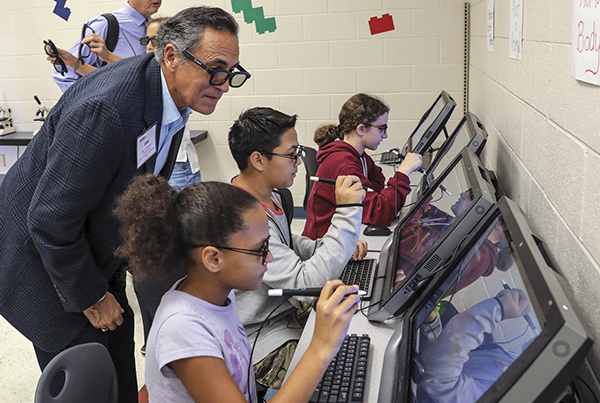
“Well, because I have a huge family,” he says. He and his wife Lori have four children, 12 grandchildren and three great-grandchildren.
Even so, his retirement seems to include some caveats.
“I’m not somebody who can stay home and play golf every day,” he says. “I have to be engaged.”
He plans to write a memoir that he hopes will be instructive to aspiring leaders. “I want that book to be kind of a professional development, where it’s not just a biography but where I incorporate my life experiences into strategies for leadership,” he says.
Domenech also expects to continue to serve on a few advisory boards (he’s been the school leadership representative on the Federal Communication Commission’s Universal Service Administrative Company board for the past 10 years), and he points out that AASA’s former presidents (he served in the elected role himself in 1998-99) tend to remain active, jointly meeting twice a year — at AASA’s National Conference and its Legislative Advocacy Conference in Washington, D.C.
“We do have this sense of a family,” he says. “It’s an organization that I’m proud of, that I love. I leave it painfully, because I know it’s time for me to move on, but at the same time I’m going to miss the organization, the people I’ve worked with, the people who have been my boards, my presidents. We’re all friends, and we’ll be friends for years.” n
Paul Riede is a freelance education writer in Nashua, N.H.
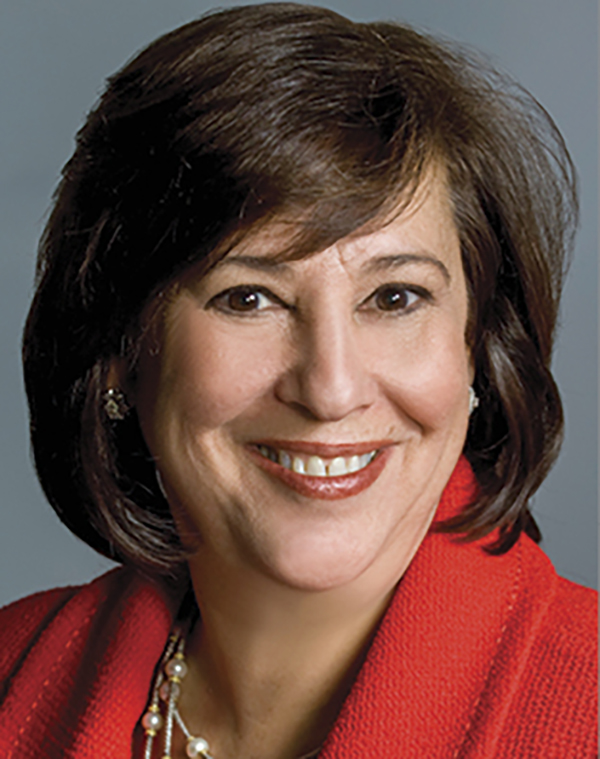 I first met Dan just a few months after he became AASA’s executive director. Abington School District was an awardee at the America’s Promise Awards Banquet in Washington, D.C., and Dan was on a panel about the importance of community engagement. The attendees were primarily community groups, being recognized for strategies that serve children.
I first met Dan just a few months after he became AASA’s executive director. Abington School District was an awardee at the America’s Promise Awards Banquet in Washington, D.C., and Dan was on a panel about the importance of community engagement. The attendees were primarily community groups, being recognized for strategies that serve children.
During his remarks, Dan casually noted that superintendents and school districts were not among the award winners. He questioned why more educators, particularly superintendents, were not in attendance. He encouraged people in the room to reach out to superintendents and to include educators in their community involvement.
When he took questions, I slowly raised my hand. Dan called on me, and I stated I am the superintendent in Abington, Pa., an active AASA member and on the AASA Governing Board. This began our almost two-decade-long relationship.
Since then, Dan has continued to be a most knowledgeable, accessible and visionary leader as well as a loyal friend and adviser, especially during my AASA presidency.
Whether advocating on Capitol Hill, addressing a group of educators and superintendents or participating on a panel discussion, he speaks for America’s children for he is the champion for children. Even when the position Dan and AASA are taking is controversial, he places the needs of children and educators at the forefront.
When Dan speaks, people listen. His wisdom, guidance, support and direction will surely be missed by everyone associated with AASA and throughout the education world.
Amy Sichel, lead superintendent with the AASA Leadership Network and a past president of AASA (2013-14)
 The first few years after Dan assumed his
position as executive director were difficult for AASA. During that period,
financial challenges and membership concerns plagued not only AASA, but most
membership-based organizations. The difference for AASA was Dan Domenech. He is
a strategic thinker who is an expert at building a future-focused, positive and
collaborative culture. Using those skills, Dan ensured AASA not only survived
the challenges, but thrived.
The first few years after Dan assumed his
position as executive director were difficult for AASA. During that period,
financial challenges and membership concerns plagued not only AASA, but most
membership-based organizations. The difference for AASA was Dan Domenech. He is
a strategic thinker who is an expert at building a future-focused, positive and
collaborative culture. Using those skills, Dan ensured AASA not only survived
the challenges, but thrived.
Under his leadership, AASA found ways to bring more value to being a member of AASA. Dan ensured AASA members had expanded benefits, additional supports plus extended professional growth and networking opportunities. Guided by Dan’s vision, AASA supported superintendents and aspiring superintendents in a myriad of meaningful ways that turned ideas into opportunities.
The proof of Dan’s incredible leadership is the fact that during his tenure as executive director, AASA grew to be recognized as the country’s premier education association.
Gail Pletnick, lead superintendent with the AASA Leadership Network and a past president of AASA (2017-18)
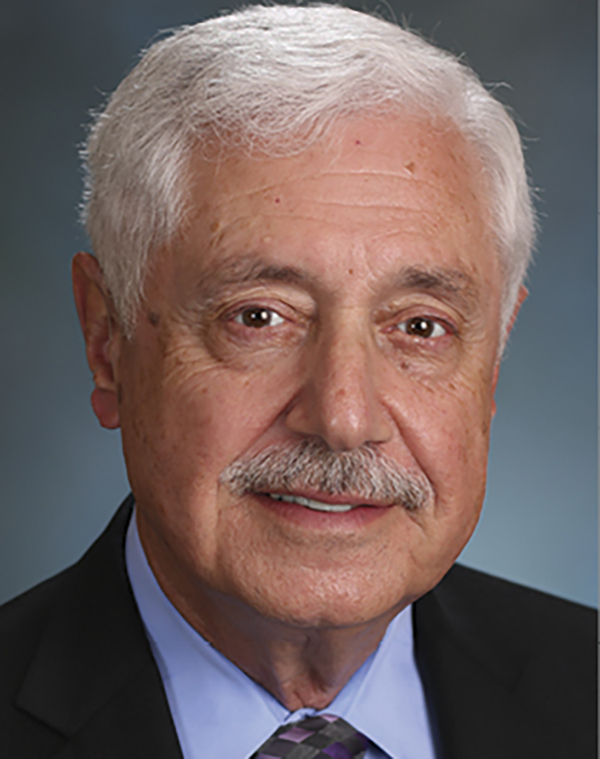 Two situations I learned about Dan Domenech
reveal how much he valued serving children.
Two situations I learned about Dan Domenech
reveal how much he valued serving children.
The first occurred when he told me that his wife, Lori, and he had volunteered to care for newborn babies before they were placed with an adoptive family. He described how much they enjoyed taking care of these infants even though doing so took a great deal of time and often deprived Lori and him of sleep. He mentioned how attached they became to those babies so when they were taken from them, the separation was often difficult.
The second involved Dan tutoring a student in the Fairfax County Public Schools during his tenure as superintendent. I know how time-consuming a superintendency can be, so I can just imagine the demands of his work schedule in a school system as large as Fairfax County. Nevertheless, he took time to prepare for the tutoring sessions, carry them out and do the requisite follow up with the student.
Even on a one-on-one personal level, Dan always has been a champion for children.
Joseph Cirasuolo, former executive director of the Connecticut Association of Public School Superintendents and past president of AASA (1999-2000)
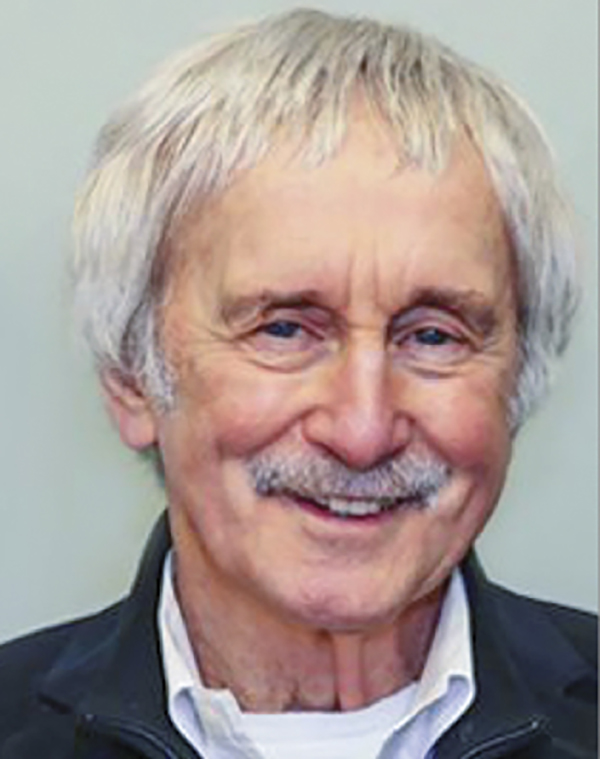 Years ago, when I first met him as the
superintendent in Fairfax County, Va., I left knowing I had just encountered
someone special. I had no contact with him until years later upon his arrival
as executive director of AASA, and a deep friendship began to bloom.
Years ago, when I first met him as the
superintendent in Fairfax County, Va., I left knowing I had just encountered
someone special. I had no contact with him until years later upon his arrival
as executive director of AASA, and a deep friendship began to bloom.
From serving on Communities In School’s state board in Virginia to chairing it, to serving on our national board, Dan’s work has left me in awe of the passion and dedication he brings to his work. He has become a close friend, in part because we share a common understanding that young people need to be turned on to living before they can be turned on to learning. He has been a true advocate for educators and the students and families they serve and has used his platform to further equity in a manner few have achieved.
Our organization has been blessed, AASA has been blessed and I personally have been blessed to have such a passionate professional in my life. Dan is equal parts head and heart. His legacy partly will be that young people and the superintendents, teachers and administrators under his leadership had someone fighting to give them hope and a future.
Bill Milliken, founder and vice chair of Communities In Schools
Author
Personal Tributes to Dan Domenech
School Administrator magazine asked a few people who’ve worked closely with AASA’s executive director during his 15-year tenure to share something memorable about him. Their remarks were edited for clarity and length, but the full versions of their tributes appear on the magazine website. See accordions below for more tributes.
Vision and Tenacity
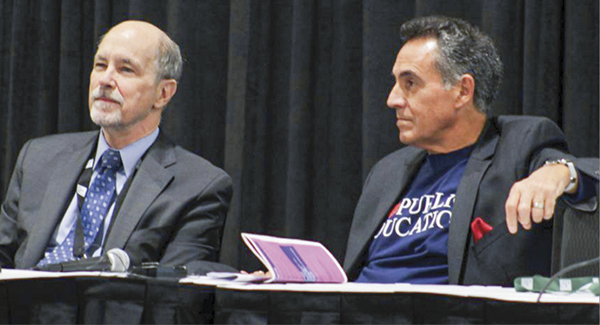 Dan
and I met formally on my first day at work at NSBA in December 2012, over lunch at a restaurant on our block. (The associations’ headquarters are across the street from each other.) We hit it off immediately.
Dan
and I met formally on my first day at work at NSBA in December 2012, over lunch at a restaurant on our block. (The associations’ headquarters are across the street from each other.) We hit it off immediately.
That easy interaction was evident in the “Dan and Tom shows” that we did at each other’s national conferences every year. We often joked we were most proud that we never planned those sessions! We took turns hosting the session at our respective conferences, but that really meant just kicking it off with a question for the other, and then we were on our way, discussing legislation in Congress, recent actions of the U.S. Department of Education as well as superintendent and school board relations, and fielding audience questions.
We had a lot of fun doing these sessions. At one, Dan and I were discussing prospects for ESSA to pass in Congress. Dan said he didn’t see any way it could happen that year, but I was more optimistic. In front of the audience, we spontaneously bet a steak dinner, which I’m happy to report I won. We later went to Morton’s, where Dan paid for my meal. The waiter took a photo of us that we both tweeted out.
On a more serious note, Dan’s efforts throughout the pandemic serve as a great example of his leadership. This really falls into two main categories. The first involves his work with the news media, especially early on when there were so many questions about how schools could continue to operate and serve kids even when they were closed for in-person instruction. I saw numerous examples of his clear, reassuring comments that were critically important during a period of such upheaval and uncertainty.
His leadership also can be seen in the ways AASA actively supports superintendents and other school leaders at a time when so many are leaving the profession. The various cohorts and other affinity groups the organization operates are a case study in how, under his leadership, AASA has moved from being a traditional association to essentially a professional society. Dan deserves great credit for his vision and tenacity in overseeing this transformation.
Thomas Gentzel, who retired as executive director of the National School Boards Association in June 2020
Resonating Themes Across a Distinguished Tenure
What follows are brief excerpts from four of the more than 150 columns that Dan Domenech composed as AASA executive director each month for School Administrator magazine.
“Making the Most of an American Opportunity” «August 2008»
This excerpt, drawn from his first column as AASA executive director, focuses on equity — a recurrent subject throughout his tenure.
“In 1998, I accompanied Paul Houston and Nolan Estes on the International Seminar to Cuba. … On a visit to one of the revolution’s museums near the Bay of Pigs site, Paul noticed the photo of a young man named Domenech who bore a striking resemblance to yours truly. The young man had been killed during the Bay of Pigs invasion. … I assumed that he might have been a cousin.
“At that moment, I became very much aware of the life, or lack thereof, that might have been mine had my family not left Cuba. Instead of having been shot at the age of 18, I was there as a visiting dignitary from the United States, superintendent of one of the largest school districts in America and president of AASA. What a country, this America!
“In 2005, more than one million individuals entered the United States as legal permanent residents. That same year, 47,000 recently immigrated students dropped out of school. …
“What a shame, because the greatest opportunity this country has to offer is access to a free public education. All that is required is that students attend, learn and use that knowledge to advance. …
“As educators, we bear a strong responsibility to ensure our students take advantage of what our schools have to offer. …
“It is a great country, this America. But we also recognize there are great challenges facing our schools. I am honored to be in a position where I will be able to work with all of you to overcome those challenges and maximize the attainment of the opportunities we face.”
“Gratifying Despite the Job’s Demands” «July 2017»
Domenech offers a paean to the tough but ultimately rewarding career of a superintendent.
“Most superintendents grow numb to the pressures of the job. … Numbness to the long hours and job pressures is a coping mechanism necessary to do the job.
“The transition out of the superintendency is like releasing the valve on a pressure cooker. …
Going into the private sector full time as I did is an option, but for those of us who’ve spent a lifetime in education, the private sector is a rude awakening. There is no question that the financial rewards in corporate America can far exceed what we received as educators, but it is a difficult transition to go from a mission-driven career as an educator to the profit-driven, bottom-line orientation in the private sector.
“Although I greatly enjoyed my tenure as a senior vice president with McGraw-Hill and I developed business skills that I wished I had known during my years as a superintendent, I jumped at the opportunity to become the executive director at AASA. The lure of getting back into education, as an advocate for my colleagues still in the profession and the students they serve, was irresistible.”
“Mind the Disruption of Personalized Learning” «October 2019»
One of several columns Domenech has written in recent years in favor of “disrupting” the traditional classroom and introducing personalized learning in schools.
“I am enamored with the disruptive innovation idea because … it will and must happen in education. … Personalized learning has the potential of being a disruptor. … When we walk into a classroom emphasizing personalized learning, we do not see the traditional rows of desks facing the front of the room with the teacher lecturing the class. Instead, we see students scattered about the room in small groups or working on their own. …
“Excitement abounds within such a classroom because students are not being bored by a lecture on a topic they already know or material they do not understand. What each student is doing is appropriate to her or his ability to understand at that very moment. …
“In a personalized learning environment, there is no remediation. In a personalized classroom, students progress at their own pace. No one is held back from advanced studies.
“I am hoping that the 20th-century education model that exists today will be disrupted by the changes that personalized learning powered by technology can bring. I believe there is a tipping point that when reached will lead to a full conversion to the new model. In only 10 years, the cellphone has transformed how we communicate. Can education be far behind?”
“The Hidden Prejudice We Harbor” «March 2021»
A call for superintendents to redouble their efforts to eliminate the persistent barriers that still face students of color in America’s schools.
“White supremacists wear their prejudice on their sleeves. However, those of us who consider ourselves to be enlightened … need to face up to the systemic racism that permeates our schools. … Why do we continue to permit and support practices that promote inequity? Is it possible that we might still unconsciously believe that children of color are intellectually inferior? …
“A persistent achievement gap remains between white students and children of color. If intellectual inferiority is not the case, what explains the achievement gap?
“Numerous studies have shown that poverty directly affects academic achievement. …
“We also are aware of the huge differences in per-pupil expenditures in school districts across America. It has given rise to the popular assertion that you can determine the level of achievement in a school by its zip code. The COVID-19 pandemic further uncovered the depth of inequity in our schools. As education pivoted to remote learning, millions of students were deprived of any learning because they did not have devices at home and/or did not have internet access. …
“Schools often are more about exclusion than inclusion. Assessments can be barriers blocking students from the educational opportunities they need most. The students with the greatest education needs are those most commonly suspended or expelled. Students who require more time to learn are forced to keep pace with the class and fail. …
“Superintendents are in the best position to eliminate the barriers to racial equity. Use the power of the office to identify the barriers in your district and move to eliminate them. In this case, action is better than words.”
Advertisement
Advertisement
Advertisement
Advertisement

.png?sfvrsn=3d584f2d_3)

